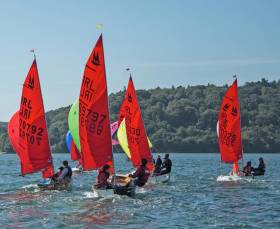Displaying items by tag: Mirror Southern Championships
Croasdell & Farrell Finish On Top In Lough Ree 1-2 At Mirror Southerns
#Mirror - Caolan Croasdell and Alexander Farrell brought the 2017 Mirror season to a close with victory in the Southern Championships on Lough Derg earlier this month.
Close behind the defending champions were fellow Lough Ree YC pairing Ben Graf and Hannah Smith, winners at the Mirror Easterns in Clontarf in late August – and who finished behind their club mates at the Mirror Worlds this summer.
The Mirror fleet also enjoyed the company of Squibs, Fireballs and Shannon One Designs over the two days of competition at Lough Derg Yacht Club.
Mirror Sailing Ireland says the year has “finished on a high” for the class as numbers in the training and racing dingy class continue to grow.
While this year’s Mirror season may be over, there’s still sailing to be done as Croasdell and Farrell are representing the class (but racing TR 3.6 double-handed dinghies) at this weekend’s All Ireland Junior Sailing Championships in Schull.
Mirror Southerns At Lough Derg Yacht Club Next Weekend
#Mirror - The 2017 Mirror racing season opens with the Southern Championships at the host venue of the 2013 Mirror Worlds, Lough Derg Yacht Club, next weekend from Saturday 20 to Sunday 21 May.
Mirror Sailing Ireland is hoping for a good turnout after a very successful winter training programme, and suggests it could be an encouraging first regional event for newcomers to the class.
With some older sailors in the class absent due to exams, it might also be a great opportunity for younger prospects to reach the podium.
























